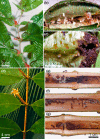Mutualistic interactions between ants and fungi: A review
- PMID: 37529578
- PMCID: PMC10375366
- DOI: 10.1002/ece3.10386
Mutualistic interactions between ants and fungi: A review
Abstract
The large amount of dead plant biomass caused by the final extinction events triggered a fungi proliferation that mostly differentiated into saprophytes degrading organic matter; others became parasites, predators, likely commensals, and mutualists. Among the last, many have relationships with ants, the most emblematic seen in the Neotropical myrmicine Attina that cultivate Basidiomycota for food. Among them, leaf-cutting, fungus-growing species illustrate an ecological innovation because they grow fungal gardens from fresh plant material rather than arthropod frass and plant debris. Myrmecophytes shelter "plant-ants" in hollow structures, the domatia, whose inner walls are lined with thin-walled Ascomycota hyphae that, in certain cases, are eaten by the ants, showing a form of convergence. Typically, these Ascomycota have antibacterial properties illustrating cases of farming for protection. Ant gardens, or mutualistic associations between certain ant species and epiphytes, shelter endophytic fungi that promote the growth of the epiphytes. Because the cell walls of certain Ascomycota hyphae remain sturdy after the death of the mycelium, they form resistant fibers used by ants to reinforce their constructions (e.g., galleries, shelters for tended hemipterans, and carton nests). Thus, we saw cases of "true" fungal agriculture involving planting, cultivating, and harvesting Basidiomycota for food with Attina. A convergence with "plant-ants" feeding on Ascomycota whose antibacterial activity is generally exploited (i.e., farming for protection). The growth of epiphytes was promoted by endophytic fungi in ant gardens. Finally, farming for structural materials occurred with, in one case, a leaf-cutting, fungus-growing ant using Ascomycota fibers to reinforce its nests.
Keywords: ant constructions; ant fungiculture; composite materials; defoliation; fungi as food.
© 2023 The Authors. Ecology and Evolution published by John Wiley & Sons Ltd.
Conflict of interest statement
The authors declare no conflicts of interest.
Figures







References
-
- Adams, R. M. M. , Liberti, J. , Illum, A. A. , Jones, T. H. , Nash, D. R. , & Boomsma, J. J. (2013). Chemically armed mercenary ants protect fungus‐farming societies. Proceedings of the National Academy of Sciences of the United States of America, 110, 15752–15757. 10.1073/pnas.1311654110 - DOI - PMC - PubMed
-
- Bailey, I. W. (1920). Some relations between ants and fungi. Ecology, 1, 174–189. 10.2307/1929134 - DOI
-
- Baker, C. C. M. , Martins, D. J. , Pelaez, J. N. , Billen, J. P. J. , Pringle, A. , Frederickson, M. E. , & Pierce, N. E. (2017). Distinctive fungal communities in an obligate African ant‐plant mutualism. Proceedings of the Royal Society of London. Series B, Biological Sciences, 284, 20162501. 10.1098/rspb.2016.2501 - DOI - PMC - PubMed
Publication types
LinkOut - more resources
Full Text Sources

